History of Nalchik
Foundation of Nalchik
The official date of foundation of Nalchik is considered to be 1724 - the time of the foundation of the first settlements on the banks of the mountain river of Nalchik at the foot of the wooded mountains of the Main Caucasian Range, when the auls of Prince Aslanbek Kaitukin moved here from the upper reaches of the Kuma River. From 1724, the auls of the main princes of Kabarda - Aslanbek Kaitukin, Dzhambot Tatarkhanov, Kuchuk Dzhankhotov - were located on the present territory of Nalchik.
The fortress of Nalchik was founded by General Aleksey Yermolov either in 1818 or in 1822, during the Caucasian War (1817-1864). The military settlement at the fortress was founded in 1838. In 1850, its population was 272 people.
In 1871, the military settlement of Nalchik was transformed into a civilian settlement (sloboda). Since that time, the local economy and industry began to develop. In 1884, about 3.5 thousand people lived in Nalchik. There were 13 brick-tile and lime factories, 4 smithies, 4 water mills, 20 inns, more than 50 shops, dozens of taverns and wine cellars.
In the late 19th and early 20th centuries, Nalchik began to turn into a resort. Thanks to the mild climate and the presence of mineral waters, it became very famous. By 1913, the population grew to 18,600 people.
More historical facts…
Nalchik in the 20th century and beyond
Nalchik sloboda received the status of a city by the decision of the Constituent Congress of Soviets of Kabardian Autonomous Oblast in 1921. At the same time, the decisions were made to build a power plant in Nalchik, as well as a mechanical plant with a foundry (later transformed into a hydro-turbine plant) and a timber mill. In 1923-1928, an elevator, a mechanized mill, and the Nalchik confectionery factory were built.
In 1923, the Lenin Educational Town was established (today’s Kabardino-Balkarian State University - one of the largest universities in the North Caucasus) with pedagogical, agricultural and cooperative technical schools. In 1939 the population of Nalchik was 47,970 people.
During the Second World War, Nalchik was occupied by the Germans from October 28, 1942 to January 3, 1943, the city was largely destroyed. About 9 thousand residents died in the battles.
On March 8, 1944, the forced deportation of the Balkars began. In total, 37,713 people were sent from the Nalchik railway station to permanent exile to Kazakhstan and Kyrgyzstan. Officially, the deportation was based on the facts of participation of the Balkars in collaborationist formations that sided with Nazi Germany during the Second World War.
Subsequently, by the highest state bodies of the USSR, and later - of Russia, this deportation was declared illegal, criminal, and an act of genocide. In 1957, a massive return of the Balkars to their homeland began. In 1959, the city’s population was 87,600.
In the 1960s-1970s, Nalchik was developed according to a new general plan corresponding to its status of a resort city. A distinctive feature of the urban development was that between the main streets with multi-storey buildings there were whole quarters of “hidden” private houses, many of which were pre-revolutionary buildings.
In the sanatoriums of Nalchik, about 36,000 people rested and were treated in 1958, 80,000 - in 1968, and 100,000 - in 1971. In the late 1980s, the Nalchik resort reached the peak in its development and presented an almost idyllic picture of the prosperity of a socialist state. In 1989, the population of Nalchik was 234,500 people.
In 1991, Nalchik became the capital of the Republic of Kabardino-Balkaria within the Russian Federation. Just as in all of Russia, the collapse of the USSR and the severance of industrial ties led to the fact that most of the city’s enterprises were closed. By 1995, the situation worsened even more when refugees from Chechnya were accommodated in local sanatoriums and rest homes. The entire resort area and city park fell into disrepair.
1997 was a turning point for Nalchik - the city began to be actively decorated and landscaped again. In 1999, by the decree of the Government of the Russian Federation, the Nalchik resort was assigned the status of a resort of federal significance.
In October 2005, the city was attacked by Islamist militants. 14 civilians and 35 police officers and law enforcement officers were killed, more than 240 people were wounded, including 129 law enforcement officers. The number of militants killed according to various sources ranges from 41 to 97 people.
In 2010, Nalchik was awarded the honorary title “City of Military Glory”.
Pictures of Nalchik
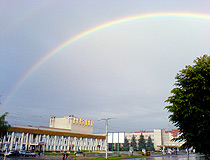
Rainbow in Nalchik
Author: Deni Altmar
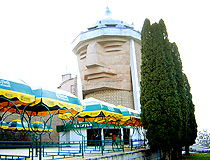
The restaurant Sosruko in Nalchik
Author: Vladimir Shelyapin
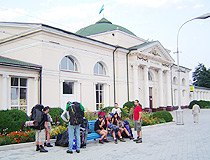
Nalchik Railway Station
Author: Karolina P.
Nalchik - Features
The Republic of Kabardino-Balkaria is one of the most beautiful and unique places in Russia in terms of natural, historical, and cultural characteristics. Nalchik, the capital of the republic, is located in its center in a picturesque area at the foot of the Main Caucasian Range at an altitude of 512 meters above sea level.
There are several versions of the origin of the city’s name. The most probable is that it got its name from the mountain river of Nalchik, which flows through its territory, and its geographical location in a semicircle of mountains resembles a horseshoe. The name of the city is based on the word “nal” - “horseshoe”, which is used in both the Kabardino-Circassian and Karachai-Balkarian languages. The horseshoe is depicted on the city’s coat of arms along with Mount Elbrus.
The climate of Nalchik is the climate of the foothill zone. The average temperature in July is plus 21 degrees Celsius, in January - minus 2.5 degrees Celsius. The main feature of the local climate is the daily fluctuations in air temperature, especially in summer.
According to the 2010 All-Russian Population Census, the ethnic composition of the population of Nalchik is as follows: Kabardians - 49.25%, Russians - 28.77%, Balkars - 12.16%, Ossetians - 2.04%. The majority of the city’s population are Sunni Muslims.
The federal highway “Caucasus” passes through Nalchik. From the Nalchik railway station, trains leave in the direction of Moscow located about 1,700 km north of it. The airport of Nalchik offers regular flights to Moscow and St. Petersburg. Minibuses (known as “marshrutka”) form the basis of the city’s public transport.
Nalchik is a fairly large industrial center. The leading branches of industry are non-ferrous metallurgy, light industry, food and pharmaceutical industries. Kabardino-Balkaria and its capital Nalchik are a popular center for tourism, mountaineering and skiing.
Due to the mild natural and climatic conditions, the presence of various mineral waters and therapeutic mud, the balneological resort of Nalchik is on a par with the resorts of the Caucasian Mineral Waters - Kislovodsk, Yessentuki, Pyatigorsk, Zheleznovodsk. About a quarter of the city is a resort area. In the resort part of the city and around it, there are about 40 sanatoriums, rest houses, tourist centers, boarding houses. On a relatively small territory of Nalchik, there are 18 mineral springs of various physical and chemical composition.
The valley of the resort is surrounded by mountains in a semicircle protecting this beautiful place from the winds. A magnificent panorama of the majestic peaks of the Greater Caucasus opens from any point.
Main Attractions of Nalchik
Atazhukinsky Garden - the largest park in the North Caucasus. Named after the Kabardian prince Atazhuko Atazhukin, it was founded in 1847. The total area is about 250 hectares, the length of the main alley - 1.5 kilometers. The park has over 150 species of plants, a river, lakes, an observation deck, sculptures, a pavilion with mineral water, a zoo, cafes and restaurants, a summer concert hall (Green Theater). In 2002, Atazhukinsky Garden was recognized as the best green park in Russia. Shogentsukova Avenue.
Nalchik Hippodrome. From time immemorial, Kabardino-Balkaria has been famous for its thoroughbred horses. Therefore, it is not surprising that one of the main attractions of Nalchik is its hippodrome. The hippodrome was built in the 1930s. In 2006, reconstruction was carried out. Horse races held here are very popular among locals and tourists. Malbakhova Street, 30.
Nalchik Central Mosque (2004) - not only one of the most original architectural objects of the city, but also a unique religious building of Islam. As conceived by the architect Andrey Asanov, not traditional canons were used in the construction of the building, but a modern high-tech style. The height of the mosque is 21 meters, the minarets - 30 meters. Shogentsukova Avenue, 133.
Restaurant “Sosruko” - one of the symbols of Nalchik. In the 1950s, it was decided to build a new restaurant in Nalchik where numerous vacationers could spend their evenings. The winner of the competition was the architect Palagashvili, who proposed to make the building recognizable and unique.
The exterior of the restaurant is stylized as a head dressed in a helmet and a hand with a flaming torch - the hero of the national epic Sosruko, who seems to grow out of a mountain 640 meters high. The helmet has an observation deck, which offers impressive panoramic views.
National Museum of the Republic of Kabardino-Balkaria. The exposition of the department of nature displays a huge relief map of the republic and samples of minerals extracted in its different parts. Slides and dioramas introduce visitors to the natural monuments, flora and fauna of Kabardino-Balkaria, the uniqueness of which is due to the presence of five climatic zones on the territory of the republic.
The historical part of the exposition tells about the most interesting archaeological finds of Kabardino-Balkaria, about the history of the Kabardians and Balkars (the indigenous inhabitants of the republic) from ancient times to the present day, about their traditions, customs, ethnography, and culture. Gorkogo Street, 62.
Kabardino-Balkarian Museum of Fine Arts named after A.L. Tkachenko. The exhibition halls of this museum showcase works of European, Russian and national artists, sculptors, masters of decorative and applied art created in the 19th-20th centuries. The pride of the museum is the collection of masterpieces created by French watchmakers of the 18th century, antique Japanese, Chinese, European, and Russian porcelain. Lenina Avenue, 35.
Chegem Waterfalls in the Chegem Gorge - a picturesque natural monument, one of the natural tourist attractions of Kabardino-Balkaria and one of the most beautiful places in Russia located about 55 km from Nalchik. Here you can also buy wool products, souvenirs, and other Kabardian and Balkar goods. There are several small cafes with national cuisine.


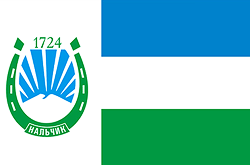
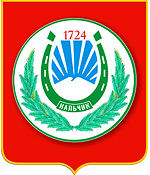
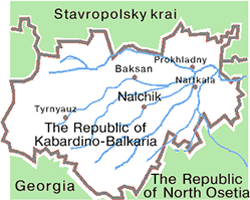



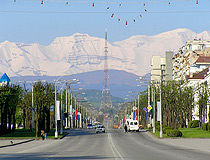
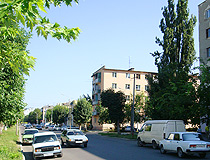
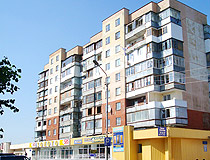
The comments of our visitors